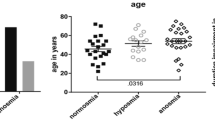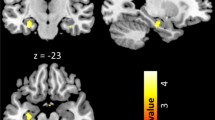Abstract
Olfactory dysfunction has been described in obsessive–compulsive disorder (OCD). Brain regions involved in smell processing partially overlap with structures included in the neurobiological models of OCD, although no previous studies have analyzed the neuroanatomical correlates of olfactory dysfunction in this disorder. The aim of our study was to examine the association between regional gray matter volume, as assessed by a voxel-based morphometry analysis of magnetic resonance images (MRI), and olfactory function, as assessed by the Sniffin’ Sticks test (SST). Olfactory function was assessed in 19 OCD patients and 19 healthy volunteers. All participants were also scanned in a 1.5-T magnet to obtain T1-weighted anatomical MRIs, which were pre-processed and analyzed with SPM8. Three different correlation models were used to study the association between regional gray matter volumes and olfactory function in the domains assessed by the SST: detection threshold, discrimination, and identification. OCD patients showed a significant impairment in all the domains assessed by the SST. Voxel-based mapping revealed a positive association in healthy controls between detection threshold and the gray matter content of a left anterior cingulate cortex cluster. In OCD patients, a positive correlation was observed between identification errors and the gray matter volume of the left medial orbital gyrus. In a post hoc analysis, these two gray matter regions were shown to be enlarged in OCD patients. Our findings support the idea that olfactory dysfunction in OCD is associated with volumetric changes in brain areas typically implicated in the neurobiology of the disorder.



Similar content being viewed by others
References
Kovacs T (2004) Mechanisms of olfactory dysfunction in aging and neurodegenerative disorders. Ageing Res Rev 3:215–232
Pardini M, Huey ED, Cavanagh AL et al (2009) Olfactory function in corticobasal syndrome and frontotemporal dementia. Arch Neurol 66:92–96
Hardy C, Rosedale M, Messinger JW et al (2012) Olfactory acuity is associated with mood and function in a pilot study of stable bipolar disorder patients. Bipolar Disord 14:109–117
Roessner V, Bleich S, Banaschewski T et al (2005) Olfactory deficits in anorexia nervosa. Eur Arch Psychiatry Clin Neurosci 255:6–9
Cumming AG, Matthews NL, Park S (2011) Olfactory identification and preference in bipolar disorder and schizophrenia. Eur Arch Psychiatry Clin Neurosci 261:251–259
Hurwitz T, Kopala L, Clark C et al (1988) Olfactory deficits in schizophrenia. Biol Psychiatry 23:123–128
Ugur T, Weisbrod M, Franzek E et al (2005) Olfactory impairment in monozygotic twins discordant for schizophrenia. Eur Arch Psychiatry Clin Neurosci 255:94–98
Segalas C, Labad J, Alonso P et al (2011) Olfactory identification and discrimination in obsessive-compulsive disorder. Depress Anxiety 28:932–940
Barnett R, Maruff P, Purcell R et al (1999) Impairment of olfactory identification in obsessive-compulsive disorder. Psychol Med 29:1227–1233
Goldberg ED, Goldberg RJ, Vannoppen B (1991) Sense of smell and obsessional behavior. Am J Psychiatry 148:1757
Hummel T, Sekinger B, Wolf SR et al (1997) ‘Sniffin’ sticks’: olfactory performance assessed by the combined testing of odor identification, odor discrimination and olfactory threshold. Chem Senses 22:39–52
Locatelli M, Bellodi L, Grassi B et al (1996) EEG power modifications in obsessive-compulsive disorder during olfactory stimulation. Biol Psychiatry 39:326–331
Hermesh H, Zohar J, Weizman A et al (1999) Orbitofrontal cortex dysfunction in obsessive-compulsive disorder? II. Olfactory quality discrimination in obsessive-compulsive disorder. Eur Neuropsychopharmacol 9:415–420
Fenger MM, Gade A, Adams KH et al (2005) Cognitive deficits in obsessive-compulsive disorder on tests of frontal lobe functions. Nord J Psychiatry 59:39–44
Wiesmann M, Kopietz R, Albrecht J et al (2006) Eye closure in darkness animates olfactory and gustatory cortical areas. Neuroimage 32:293–300
Cerf-Ducastel B, Murphy C (2003) FMRI brain activation in response to odors is reduced in primary olfactory areas of elderly subjects. Brain Res 986:39–53
Rolls ET, Grabenhorst F, Margot C et al (2008) Selective attention to affective value alters how the brain processes olfactory stimuli. J Cogn Neurosci 20:1815–1826
Rolls ET, Kringelbach ML, De Araujo IE (2003) Different representations of pleasant and unpleasant odours in the human brain. Eur J Neurosci 18:695–703
Anderson AK, Christoff K, Stappen I et al (2003) Dissociated neural representations of intensity and valence in human olfaction. Nat Neurosci 6:196–202
Zald DH, Pardo JV (1997) Emotion, olfaction, and the human amygdala: amygdala activation during aversive olfactory stimulation. Proc Natl Acad Sci USA 94:4119–4124
Frasnelli J, Lundstrom JN, Boyle JA et al (2010) Neuroanatomical correlates of olfactory performance. Exp Brain Res 201:1–11
Pujol J, Soriano-Mas C, Alonso P et al (2004) Mapping structural brain alterations in obsessive-compulsive disorder. Arch Gen Psychiatry 61:720–730
Valente AA Jr, Miguel EC, Castro CC et al (2005) Regional gray matter abnormalities in obsessive-compulsive disorder: a voxel-based morphometry study. Biol Psychiatry 58:479–487
Rotge JY, Guehl D, Dilharreguy B et al (2009) Meta-analysis of brain volume changes in obsessive-compulsive disorder. Biol Psychiatry 65:75–83
Rotge JY, Langbour N, Guehl D et al (2010) Gray matter alterations in obsessive-compulsive disorder: an anatomic likelihood estimation meta-analysis. Neuropsychopharmacology 35:686–691
Szeszko PR, Robinson D, Alvir JM et al (1999) Orbital frontal and amygdala volume reductions in obsessive-compulsive disorder. Arch Gen Psychiatry 56:913–919
American Psychiatric Association (1994) Diagnostic and statistical manual of mental disorders, 4th edn. American Psychiatric Association, Washington
First N, Spitzer R, Gibbon M et al (1997) Structured clinical interview for DSM-IV axis I disorders-clinician version. American Psychiatric Press, Inc., Washington, DC
Goodman WK, Price LH, Rasmussen SA et al (1989) The Yale-Brown Obsessive Compulsive Scale. I. Development, use, and reliability. Arch Gen Psychiatry 46:1006–1011
Hamilton M (1960) A rating scale for depression. J Neurol Neurosurg Psychiatry 23:56–62
Hamilton M (1959) The assessment of anxiety states by rating. Br J Med Psychol 32:50–55
Ashburner J (2007) A fast diffeomorphic image registration algorithm. Neuroimage 38:95–113
Aschenbrenner K, Scholze N, Joraschky P et al (2008) Gustatory and olfactory sensitivity in patients with anorexia and bulimia in the course of treatment. J Psychiatr Res 43:129–137
Naudin M, El-Hage W, Gomes M et al (2012) State and trait olfactory markers of major depression. PLoS ONE 7:e46938
Tien RD, Felsberg GJ, Krishnan R et al (1994) MR imaging of diseases of the limbic system. AJR Am J Roentgenol 163:657–665
Bitter T, Bruderle J, Gudziol H et al (2010) Gray and white matter reduction in hyposmic subjects–a voxel-based morphometry study. Brain Res 1347:42–47
Bitter T, Gudziol H, Burmeister HP et al (2010) Anosmia leads to a loss of gray matter in cortical brain areas. Chem Senses 35:407–415
Radua J, Mataix-Cols D (2009) Voxel-wise meta-analysis of grey matter changes in obsessive-compulsive disorder. Br J Psychiatry 195:393–402
Szeszko PR, Christian C, Macmaster F et al (2008) Gray matter structural alterations in psychotropic drug-naive pediatric obsessive-compulsive disorder: an optimized voxel-based morphometry study. Am J Psychiatry 165:1299–1307
Szeszko PR, Macmillan S, Mcmeniman M et al (2004) Brain structural abnormalities in psychotropic drug-naive pediatric patients with obsessive-compulsive disorder. Am J Psychiatry 161:1049–1056
Zatorre RJ, Jones-Gotman M, Evans AC et al (1992) Functional localization and lateralization of human olfactory cortex. Nature 360:339–340
Gottfried JA, Zald DH (2005) On the scent of human olfactory orbitofrontal cortex: meta-analysis and comparison to non-human primates. Brain Res Brain Res Rev 50:287–304
AaS Donald, Stevenson RJ (2003) The fundamental role of memory in olfactory performance. Trends Neurosci 26:243–247
Nguyen AD, Pelavin PE, Shenton ME et al (2011) Olfactory sulcal depth and olfactory bulb volume in patients with schizophrenia: an MRI study. Brain Imaging Behav 5:252–261
Wang J, You H, Liu JF et al (2011) Association of olfactory bulb volume and olfactory sulcus depth with olfactory function in patients with Parkinson disease. AJNR Am J Neuroradiol 32:677–681
Kim JY, Lee WY, Chung EJ et al (2007) Analysis of olfactory function and the depth of olfactory sulcus in patients with Parkinson’s disease. Mov Disord 22:1563–1566
Cardoner N, Soriano-Mas C, Pujol J et al (2007) Brain structural correlates of depressive comorbidity in obsessive-compulsive disorder. Neuroimage 38:413–421
Savic I (2002) Imaging of brain activation by odorants in humans. Curr Opin Neurobiol 12:455–461
Seubert J, Freiherr J, Frasnelli J et al (2012) Orbitofrontal cortex and olfactory bulb volume predict distinct aspects of olfactory performance in healthy subjects. Cereb Cortex (Epub ahead of print)
Carey RM, Verhagen JV, Wesson DW et al (2009) Temporal structure of receptor neuron input to the olfactory bulb imaged in behaving rats. J Neurophysiol 101:1073–1088
Szendi I, Racsmany M, Cimmer C et al (2010) Two subgroups of schizophrenia identified by systematic cognitive neuropsychiatric mapping. Eur Arch Psychiatry Clin Neurosci 260:257–266
Katotomichelakis M, Balatsouras D, Tripsianis G et al (2007) The effect of smoking on the olfactory function. Rhinology 45:273–280
Acknowledgments
This study was supported in part by the Carlos III Health Institute (PI09/01331 PI10/01753, PI10/01003, CP10/00604, CIBER-CB06/03/0034) and by the Agencia de Gestió d’Ajuts Universitaris i de Recerca (AGAUR; 2009SGR1554). Dr. Soriano-Mas is funded by a “Miguel Servet” contract from the Carlos III Health Institute (CP10/00604). Eva Real is supported by a “Río Hortega” contract from the Carlos III Health Institute (I.D. CM11/00077). Marta Subirà is funded by a pre-doctoral grant from the Bellvitge Biomedical Research Institute (IDIBELL). Clara López is supported by a pre-doctoral grant from the Ministry of Education, Culture and Sport (FPU12/01636). Dr. Harrison is supported by a National Health and Medical Research Council of Australia (NHMRC) Clinical Career Development Award (I.D. 628509). We thank Gerald Fannon for revising the manuscript.
Conflict of interest
None.
Author information
Authors and Affiliations
Corresponding author
Rights and permissions
About this article
Cite this article
Segalàs, C., Alonso, P., Orbegozo, A. et al. Brain structural imaging correlates of olfactory dysfunction in obsessive–compulsive disorder. Eur Arch Psychiatry Clin Neurosci 264, 225–233 (2014). https://doi.org/10.1007/s00406-013-0439-7
Received:
Accepted:
Published:
Issue Date:
DOI: https://doi.org/10.1007/s00406-013-0439-7




